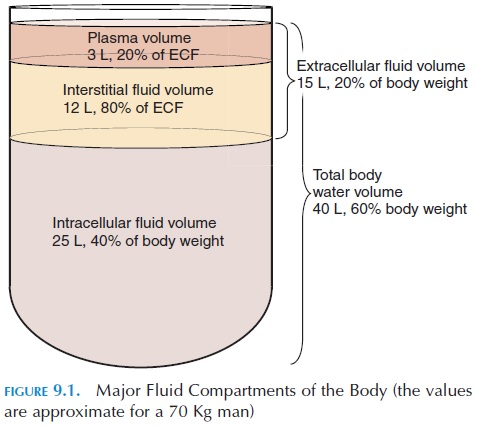Chapter: The Massage Connection ANATOMY AND PHYSIOLOGY : Lymphatic System
Body Fluid Compartments

Body Fluid Compartments
Did you know that an adult body contains approxi-mately 40 liters (84.5 pt) of water? Visualize the vol-ume of 40 1-liter milk containers in the dairy section of your grocery store. About 25 liters (52.8 pt) of this fluid is found inside the cells—intracellular fluid (see Figure 9.1). The remaining 15 liters (31.7 pt) is

Of the extracellular fluid, about 12 liters (25.4 pt) are lo-cated between the cells (interstitial fluid) and 3 liters (6.3 pt) are located inside blood vessels as plasma or intravascular fluid (remember that theblood volume of about 5 liters (10.6 pt) is made up of this fluid, together with the blood cells).
The fluid in the blood and the interstitial region is continuously being mixed as it diffuses in and out of the blood capillaries. Therefore, the waste products of the cells, which have diffused out into the space between the cells (interstitial space), enter the blood and are transported to the excretory organs, while the nutrients required by the cells enter the interstitial space from the blood by diffusion.
Despite the rapid mixing of extracellular fluid, the volume of fluid in the plasma and the interstitial re-gion remains constant. The various physical forces that cause movement through the pores in the capil-laries maintain this constancy.
PHYSICAL FORCES THAT CAUSE MOVEMENTOF FLUID BETWEEN COMPARTMENTS
One force that tends to push fluid out of the capillar-ies is capillary hydrostatic pressure. In the body, this pressure is equal to about 17 mm Hg. If you can imagine a nick in your garden hose, 17 mm Hg is equivalent to the pressure that forces the water out through the nick. If you increase the flow of water through the garden hose by opening the tap, more water will leak out of the nick. Similarly, any factor that causes an increase in the pressure inside capil-laries will increase the volume of water moving out of the capillaries. For example, if there is more blood flowing through the capillaries as a result of artery di-latation, or if more pressure builds in the capillaries because blood flow into the vein is impeded, more fluids will move out of the capillaries.
Another force that affects fluid movement between the fluid compartments is interstitial colloid osmoticpressure, caused by the proteins in the interstitialfluid. These proteins draw water from the capillaries toward the interstitial compartment by osmosis, caus-ing a pressure equal to about 5 mm Hg. If more protein leaks into the interstitial com-partment from the capillaries or from the cells, more water is drawn from the capillaries by osmosis. This situation occurs when an area of the body is inflamed. During inflammation, the capillaries dilate and protein leaks out of the capillaries, drawing water along with them. This is one mechanism that produces swelling.
The interstitial compartment has a negativehy-drostatic pressure equal to 6 mm Hg, about thesame as the suction force around your garden hose. This force, if exerting its effect alone, will tend to suck the fluid out of the capillaries. However, if this force is positive, the fluid tends to move from the in-terstitial compartment to the inside of capillaries.
The plasma protein inside the capillaries is an-other force that plays a part in fluid movement. These proteins, similar to the interstitial fluid protein, draw fluid into the compartment in which they are located; in this case, the plasma. This force is called plasmacolloid osmotic pressure and is equal to 28 mm Hg.In conditions such as severe malnutrition in which plasma protein is decreased, less fluid is drawn into the blood vessels and more moves into the interstitial compartment, producing swelling. This swelling, caused by fluid accumulation in the interstitial com-partment, is known as edema. The movement of fluid out of the capillaries also depends on the per-meability of capillaries.
Normally, the excess fluid and protein that accumu-lates in the interstitial fluid compartment is removed by the lymphatic system. The activity of the lymphatic system determines the volume of fluid present. Edema results if lymph drainage from a region is reduced.
Therefore, there are various forces acting in differ-ent directions simultaneously, and the direction in which the fluid moves into or out of the capillaries depends on which net force predominates.
Can you now determine which of the above forces draws fluid out of the capillaries and which draws fluid into the capillaries?
EDEMA
When the net force pushing fluid out of the capillar-ies predominates, fluid tends to accumulate in the in-terstitial fluid compartment. This increase of fluid in the interstitial fluid compartment is known as edema. Edema caused by low output of the lymphatic sys-tem, with resultant high levels of protein in the inter-stitial fluid is calledlymphedema. The physiologic factors that result in edema are listed in Table 9.1. Try to think of conditions that may present with edema as a result of one or more of these physiologic causes.

Related Topics